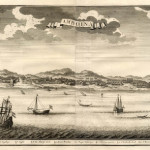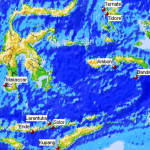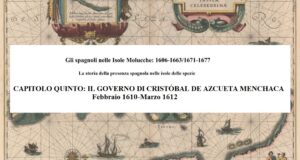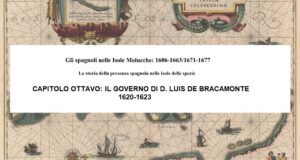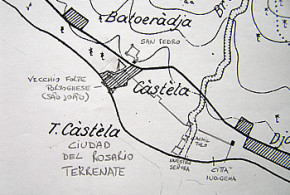Written by Marco Ramerini. English text revision by Dietrich Köster.
Ambon is an island located in the south of the Spice Islands in what is today the Indonesian archipelago.
In the year 1569 the Portuguese Gonçalo Pereira Marramaque erected a wooden fort on the northern coast of the Ambon island. In 1572 the fort was moved to the southern side of the bay. Subsequently Sancho de Vasconcelos built a temporary fort at Gelala and another at Batumarah, both of wood; and finally he built a stone fortress, where the town of Ambon is situated today.
The first stone was laid on 25 March 1576 and the fortress was named “Nossa Senhora da Anunciada”. In July 1576 the new fortress was inaugurated. Inside the square-sized construction crowned with four towers, one at each corner, there were the captain’s residence, a meeting room, some storehouses and dwellings for the military officials.
The town was built around the fortress and was divided into several quarters, all inhabited by Christians. The Portuguese town was not walled, only the Jesuits (in Ambon since 1578) had a stone wall around their garden to protect themselves against attacks of enemy villages. Near their residence was the church of “Sant’ Iago” (1581) covered by a thatched roof.
The Jesuits also cared for the church of São Tomé (1581). They used their residence in Ambon like a pastoral center for Ambon and the three Lease Islands: Haruku, Saparua, Nusalaut. The Ambon residence was for some years (1575-1578) the center of the Moluccas Jesuit mission.
Along the shore was situated the oldest church of Ambon called “São Paulo”, a fortress church. Near the southeastern side of the fort were the hospital and the “Igreja da Misericórdia”. This brotherhood “Confraria da Misericórdia” was founded in 1579.
The town of Ambon was besieged many times. Its history is a history of war. In 1591 and in 1593 it was besieged by the Ternatans; in 1598 by the Javanese; in 1600 by the Dutch; finally on 23 February 1605 the Portuguese fortress surrendered to the Dutch.
- Ambon (1724-26). Author François Valentyn
- The Portuguese settlements on the Lesser Sunda islands and on the Moluccas (1500-1600). Author Marco Ramerini
BIBLIOGRAPHY:
– Jacobs, Hubert “The Portuguese town of Ambon, 1567-1605” In: Various Authors “II Seminário Internacional de História Indo–Portuguesa” 601-614 pp. IICT & CEHCA 1985 Lisbon, Portugal.
– Jacobs, Hubert “Documenta Malucensia” Vol. I-II-III Vol. I 1542-1577. XLII-84*-760 pp. (vol. 109). Monumenta Historica Societatis Iesu, 1974, Roma, Italia. Vol. II 1577-1605. XXXII-65*-794 pp. (vol. 119). Monumenta Historica Societatis Iesu, 1980, Roma, Italia. Vol. III 1606-1682. XXIV-54*-778 pp. (vol. 126). Monumenta Historica Societatis Iesu, 1984, Roma, Italia.
 Colonial Voyage The website dedicated to the Colonial History
Colonial Voyage The website dedicated to the Colonial History
